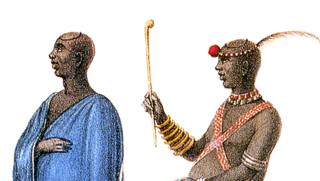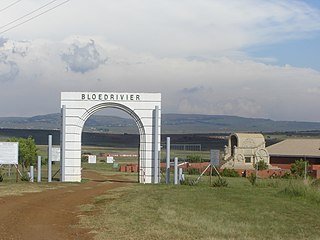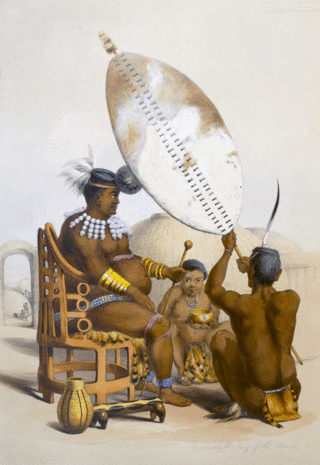
Shaka kaSenzangakhona, also known as Shaka Zulu and Sigidi kaSenzangakhona, was the king of the Zulu Kingdom from 1816 to 1828. One of the most influential monarchs of the Zulu, he ordered wide-reaching reforms that re-organized the military into a formidable force.

The Anglo-Zulu War was fought in 1879 between the British Empire and the Zulu Kingdom. Following the passing of the British North America Act of 1867 forming a federation in Canada, Lord Carnarvon thought that a similar political effort, coupled with military campaigns, might succeed with the African Kingdoms, tribal areas and Boer republics in South Africa. In 1874, Sir Bartle Frere was sent to South Africa as High Commissioner for the British Empire to effect such plans. Among the obstacles were the armed independent states of the South African Republic and the Kingdom of Zululand.

Dingane ka Senzangakhona Zulu, commonly referred to as Dingane or Dingaan, was a Zulu prince who became king of the Zulu Kingdom in 1828, after assassinating his half-brother Shaka Zulu. He set up his royal capital, uMgungundlovu, and one of numerous military encampments, or kraals, in the eMakhosini Valley just south of the White Umfolozi River, on the slope of Lion Hill (Singonyama).

Andries Wilhelmus Jacobus Pretorius was a leader of the Boers who was instrumental in the creation of the South African Republic, as well as the earlier but short-lived Natalia Republic, in present-day South Africa. The large city of Pretoria, executive capital of South Africa, is named after him.

The Battle of Blood River was fought on the bank of the Ncome River, in what is today KwaZulu-Natal, South Africa between 464 Voortrekkers ("Pioneers"), led by Andries Pretorius, and an estimated 10,000 to 15,000 Zulu. Estimations of casualties amounted to over 3,000 of King Dingane's soldiers dead, including two Zulu princes competing with Prince Mpande for the Zulu throne. Three Voortrekker commando members were lightly wounded, including Pretorius.
The year 1838 was the most difficult period for the Voortrekkers from when they left the Cape Colony, till the end of the Great Trek. They faced many difficulties and much bloodshed before they found freedom and a safe homeland in their Republic of Natalia. This was only achieved after defeating the Zulu Kingdom, at the Battle of Blood River, which took place on Sunday 16 December 1838. This battle would not have taken place if the Zulu King had honoured the agreement that he had made with the Voortrekkers to live together peacefully. The Zulu king knew that they outnumbered the Voortrekkers and decided to overthrow them and that led to the Battle of Blood river.

Mpande kaSenzangakhona was monarch of the Zulu Kingdom from 1840 to 1872. He was a half-brother of Sigujana, Shaka and Dingane, who preceded him as Zulu kings. He came to power after he had overthrown Dingane in 1840.

Cetshwayo kaMpande was the king of the Zulu Kingdom from 1873 to 1879 and its Commander in Chief during the Anglo-Zulu War of 1879. His name has been transliterated as Cetawayo, Cetewayo, Cetywajo and Ketchwayo. Cetshwayo consistently opposed the war and sought fruitlessly to make peace with the British, and was defeated and exiled following the Zulu defeat in the war. He was later allowed to return to Zululand, where he died in 1884.
King Senzangakhona kaJama was the king of the Zulu Kingdom, and primarily notable as the father of three Zulu kings who ruled during the period when the Zulus achieved prominence, led by his oldest son King Shaka.

The Natalia Republic was a short-lived Boer republic founded in 1839 after a Voortrekker victory against the Zulus at the Battle of Blood River. The area was previously named Natália by Portuguese sailors, due to its discovery on Christmas. The republic came to an end in 1843 when British forces annexed it to form the Colony of Natal. After the British annexation of the Natalia Republic, most local Voortrekkers trekked northwest into Transorangia, later known as the Orange Free State, and the South African Republic.
Wakkerstroom,, is the second oldest town in Mpumalanga province, South Africa. The town is on the KwaZulu-Natal border, 27 km east of Volksrust and 56 km south-east of Amersfoort.

The Zulu royal family, also known as the House of Zulu consists of the king of the Zulus, his consorts, and all of his legitimate descendants. The legitimate descendants of all previous kings are also sometimes considered to be members.

Sigananda kaZokufa was a Zulu aristocrat whose life spanned the reigns of four Zulu kings in southeastern Africa. According to oral history, Sigananda's grandfather was chief Mvakela, who married a sister of Nandi, King Shaka's mother, and that his father was Inkosi Zokufa. He also said he had a son called Ndabaningi.
INduna is a Zulu/Xhosa title meaning advisor, great leader, ambassador, headman or commander of a group of warriors. It can also mean spokesperson or mediator, as the iziNduna often acted as a bridge between the people and the king. The title was reserved for senior officials appointed by the king or chief and was awarded to individuals held in high esteem for their qualities of leadership, bravery or service to the community. The iziNduna would regularly gather for an indaba to discuss important issues.

The Zulu Kingdom, sometimes referred to as the Zulu Empire or the Kingdom of Zululand, was a monarchy in Southern Africa. During the 1810s, Shaka established a modern standing army that consolidated rival clans and built a large following which ruled a wide expanse of Southern Africa that extended along the coast of the Indian Ocean from the Tugela River in the south to the Pongola River in the north.

Dabulamanzi kaMpande was a Zulu commander for the Zulu kingdom in the Anglo-Zulu War. He is most noted for having commanded the Zulus at the Battle of Rorke's Drift. He was a half-brother of the Zulu king Cetshwayo kaMpande.

uMgungundlovu was the royal capital of the Zulu King Dingane (1828–1840) and one of several military complexes which he maintained. He established his royal kraal in 1829 in the eMakhosini valley against Lion hill (Singonyama), just south of the White Umfolozi River.

The Battle of Ndondakusuka was the culmination of a succession struggle in the Zulu Kingdom between Cetshwayo and Mbuyazi, the two eldest sons of the king Mpande, often known as the Second Zulu Civil War. Mbuyazi was defeated at the battle and was killed, leaving Cetshwayo in de facto control of the kingdom, though his father remained king. Mbuyazi's followers were massacred in the aftermath of the battle, including five other sons of King Mpande.

The Battle of Maqongqo was fought on 29 January 1840 during the First Zulu Civil War. Due to military defeats, the Zulu king Dingane had lost the respect of a significant portion of the Zulu people. His brother Mpande sought to separate his followers from Dingane and drew support from an alliance with Boer settlers led by Andries Pretorius.
Nongalaza KaNondela was a Zulu warrior who was the principal military commander of King Mpande of the Zulu kingdom.
Princess Mkabayi kaJama was a Zulu princess, the head of the Qulusi military kraal, and a regent of the Zulu Kingdom. She persuaded her father, the Zulu King Jama kaNdaba, to remarry, and acted as a regent during the reign of her half-brother, Senzangakhona.














